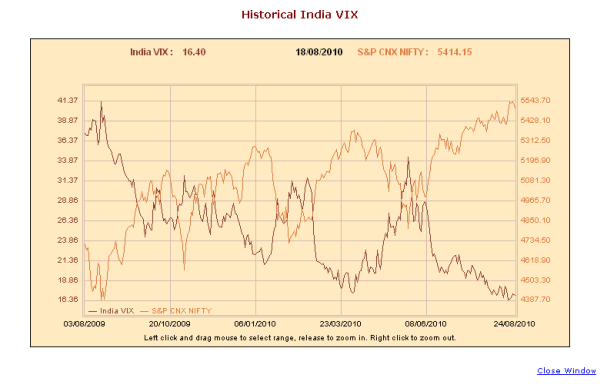India Vix Calculations
Before we understand how India Vix (India Volatility index) is calculated, let’s understand what is volatility and what is volatility index.
Volatility refers to the amount of uncertainty or risk about the size of changes in a security or index value. A higher volatility means that a security’s value can potentially vary over a larger range of values. This means that the price of the security can change dramatically. A lower volatility means that a security’s value does not fluctuate dramatically, but changes in value at a steady pace over a period of time.
The Volatility Index, sometimes referred as the fear index, indicates the volatility in the market at present or in the near future. India VIX indicates the market’s perception of the expected near term volatility. All securities portfolios as well as stock market indices are subjected to volatility and thus the studying them can be helpful because options prices are chiefly governed by the volatility in the market.
Calculations for India VIX: India VIX is a volatility index based on the index option prices of NSE’s benchmark index NIFTY. India VIX uses the computation methodology of CBOE, with suitable amendments to adapt to the NIFTY options order book. India VIX is computed using the best bid and ask quotes of the out-of-the-money near and mid-month NIFTY option contracts, which are traded on the F&O segment of NSE. There are several factors which are used to calculate the index. Some important ones are these –
1) Time to Expiry: Time to expiry of the options contracts of Nifty that are selected to calculate the index. The time to expiry is computed in minutes instead of days in order to arrive at a level of precision expected by professional traders.
2) Interest Rate: The NSE Mibor rate of relevant tenure (i.e 30 days or 90 days) is being considered as risk-free interest rate for the respective expiry months of the NIFTY option contracts.
3) The Forward Index Level: A methodology called the forward index level is being used to select the contracts which will be used to calculate the index. India VIX is computed using out-of-the-money option contracts. Out-of-the-money option contracts are identified using forward index level. The forward index level helps in determining the at-the-money (ATM) strike which in turn helps in selecting the option contracts which shall be used for computing India VIX. The forward index level is taken as the latest available price of NIFTY future contract for the respective expiry month.
4) Bid-Ask Quotes: The strike price of NIFTY option contract available just below the forward index level is taken as the ATM strike. NIFTY option Call contracts with strike price above the ATM strike and NIFTY option Put contracts with strike price below the ATM strike are identified as out-of-the-money options and best bid and ask quotes of such option contracts are used for computation of India VIX. In respect of strikes for which appropriate quotes are not available, values are arrived through interpolation using a statistical method namely “Natural Cubic Spline”. After identification of the quotes, the variance (volatility squared) is computed separately for near and mid month expiry.
5) Weightage: The variance is computed by providing weightages to each of the NIFTY option contracts identified for the computation, as per the CBOE method. The weightage of a single options contract is directly proportional to the average of best bid-ask spread of that option contract and inversely proportional to the option contract’s strike price.
Finally, the variance for the near and mid month expiry computed separately are interpolated to get a single variance value with a constant maturity of 30 days to expiration. The square root of the computed variance value is multiplied by 100 to arrive at the India VIX value. In a nutshell, from usage point of view, higher the vix index value, higher the volatility.
Further Readings
India Vix Basics
How India Vix is related to Nifty Options
Future of India Vix Futures
